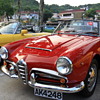Posted 11 years ago
 bohemiangl…
bohemiangl…
(647 items)
The style of this impressive vase comes from the Orientalisierende (Orientalist) movement in Austrian art, which lasted from approximately 1880 through about 1900, when the transition to art nouveau/jugendstil was basically complete. The form number is unknown, but dates to about 1892, based on a comparison to a vase in the same size and shape (38.2 cm tall, or just over 15") that exists in the Glasmuseum Passau that is decorated in flowering sakura branches (cherry blossoms), known as Dek III/115, which was exhibited at the World's Fair in Chicago in 1893. (see last photo for a scan of the PMC vase)
This vase is pure heliotrope in color - (I use the term heliotrope here to describe the color as I see it, not necessarily to imply any official Loetz designation). It is decorated elaborately in middle-Eastern themed windowpanes surrounded by opal frit, with heavy gold enameled scrolls and starbursts covering the whole vase. The clear (frit-free) panels are surrounded by borders of white enameled dots (a motif also used extensively by Harrach in the 1880s to about 1890).
A friend this morning said something I liked - that "Victorian is where jugenstil comes from". To me, these two pieces show a peek at what the beginning of that transition must have looked like.
Very little has been published about this period of Loetz production, but research is ongoing. Stay tuned for updates as more information comes to light.









































Great information and analogy. I love the shape and décor ....stunning and fit for being an Early Loetz example...one of the finest..if I may add :) Warren, great score!
Stunning example of 19th century Loetz, it's very interesting how they were able to effectively recycle old Japanese and Islamic designs into, new art, or Art Nouveau.
What a fantastic vase really well done
Stunning enameling work...beautiful vase...:-)
Amazing work. It looks like some areas are acid bathed giving a rough texture, while others are clear. So much work went into this piece.
It shows that Loetz paid attention to high quality long before the art nouveau period and employed highly skilled workers.
Hi BG&M
Lovely piece ... Was hoping the asking price would come back a little more ... darn!
The "frit" is coralline / Moriage rather than bead / sand blasted ?
Cheers
... that was a question btw ... :-)
Steve, it's finer than coralene. Moriage is a term I usually associate with porcelain, so I would just call it frit for want of a better term.
Beautiful :)